In his 2021 book, Nuclear Folly, Harvard professor Serhii Plokhy reports new information on the Cuban missile crisis, as seen from both the US and Soviet governments. As background to the story, he relates that the Soviet Premier, Nikita Khrushchev, wanted John Kennedy to win the November 1960 US presidential election, believing he would be weaker than his opponent, Richard Nixon. He had the KGB offer help through Robert Kennedy. The latter suggested the Soviets remain neutral. Nevertheless, Khrushchev would claim he got Kennedy elected.
This document is based on information in Professor Plokhy’s book. Where additional sources are used, they are footnoted. Plokhy obtained extensive new information from Russian and Ukrainian sources pertaining to the period of the Cuban Missile Crisis that is distilled in this review. It is an effort to chronicle and illuminate the changing views held by the leadership of the US and USSR throughout the period of the crisis and to place within that timeline the outside incidents and political pressures that confronted the leaders.
The Cuban Missile Crisis of 1962 was the most dangerous moment in World History
The Soviet Union had delivered missiles and nuclear weapons to Cuba to counter the US nuclear superiority months before their mid-October discovery by a US U-2 spy flight. The weapons had a range of 1,290 miles, putting Washington, D.C. and other major US cities in jeopardy. This was one of the worst intelligence failures in American history. As the US struggled to deal with the threat and the Soviets sought to counter the US demand for removal of the weapons, the Kennedy administration suffered from misinformation, miscalculations and misperceptions,” according to Robert McNamara, Kennedy’s Secretary of Defense. The same issues plagued the Soviet leadership.
The Cuban Missile Crisis could have been a disaster; that it ended peacefully owes something to luck and a lot to the leaders’ fear of a nuclear war. Kennedy was always wary, but Khrushchev was willing to take more risks because he thought he could outwit and bully his adversaries into submission; then he wouldn’t have to follow through on his threats of using nuclear weapons. Looking back on those days with the information that is now available, it is clear that Kennedy and Khrushchev were constantly guessing – and often guessing wrongly — as to the intent and actions of the other. Each side thought the other was going to start a war, and misinterpreted letters received from the other. Actions taken by one side were not known in ‘real time’ by the other, for example, the US didn’t know for hours that one of its U-2 planes had been shot down over Cuba; the Soviet Navy did not know that incendiary devices dropped from a US plane were to enable photography and not an attempt to attack their submarine. The element of luck prevented that submarine from firing a nuclear-tipped missile at a nearby US ship.
The following chronology of events leading up to and during the Cuban Missile Crisis provides background but omits the drama that is well revealed in Plokhy’s book.
The Background
At the start of the Kennedy administration, US military power was superior to that of the Soviet Union, but the US did not know that. John Kennedy believed the Soviets were ahead and had campaigned on that issue. Soviet Premier Nikita Khrushchev bluffed and bragged about their supposed superiority, while seeking to change the balance. Khrushchev was pursuing a deliberate, high risk policy that he announced in January 1962 in a speech in the Kremlin to the Presidium. Putting nuclear missiles in Cuba became part of that plan.1
April 1959 and October 1959
- Late in the Eisenhower administration, plans were made to deploy 15 Jupiter missiles with a range of 2400 km (1440 miles) in Italy and Turkey. The installations were completed between 1961 and 1963. President Charles de Gaulle had refused to allow Jupiter missiles to be deployed In France. 2
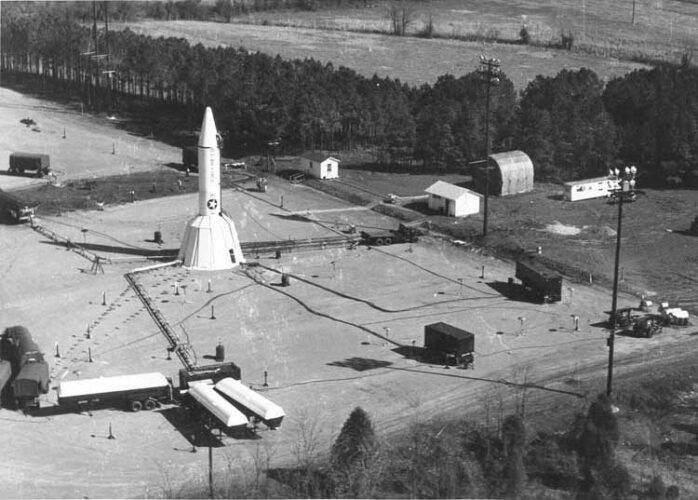 US Jupiter Missile
US Jupiter Missile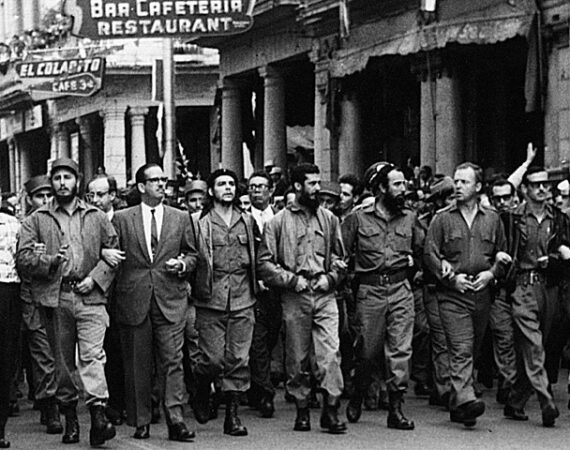 Celebrating Cuban Revolution. Fidel Castro on left.
Celebrating Cuban Revolution. Fidel Castro on left.
May 1960
- Khrushchev threatened the US with nuclear arms in order to protect Cuba’s independence.The USSR shot down a US U-2 spy plane flying over the Soviet Union.
July 1960
- Cuba’s President Fidel Castro nationalized, without compensation, all US-owned businesses and properties in Cuba. Then-President Eisenhower retaliated by closing US markets to Cuban sugar imports. Eisenhower wanted political exiles to initiate a popular uprising to remove Castro from power. To that end, the CIA crafted a plan—but it was left for the new president to implement.
October 1960
- Castro was aware of the US-backed guerrilla training camps in Guatemala as were Cuban exiles in Miami. 3
The Kennedy Presidency Begins
January 1961
- The CIA presented its plan to oust Castro to Kennedy before his inauguration. 4
February 1961
- Kennedy authorized the CIA plan to invade Cuba, requiring that US support be disguised. 5
- The US test of the solid fuel powered Minuteman missile was successful. The Minuteman could be launched immediately (without the fueling delay of the liquid-fueled missiles that the USSR had) and could be stored in nearly impregnable silos.6
April 12, 1961
- Soviet cosmonaut Yuri Gagarin became the first man in space. His orbit of the earth took 89 minutes.7
April 17 – 20, 1961
- 1400 Cuban exiles, trained by the US, launched an invasion at the Bay of Pigs on the south coast of Cuba. The poorly planned US-backed invasion was quickly defeated, but Cuba’s new revolutionary leader, Fidel Castro, sought the future protection of military backing from the Soviet Union. Following the failed effort to remove Castro, the Kennedy administration initiated Operation Mongoose – a plan to sabotage and destabilize the Cuban government and economy, which included the possibility of assassinating Castro.8
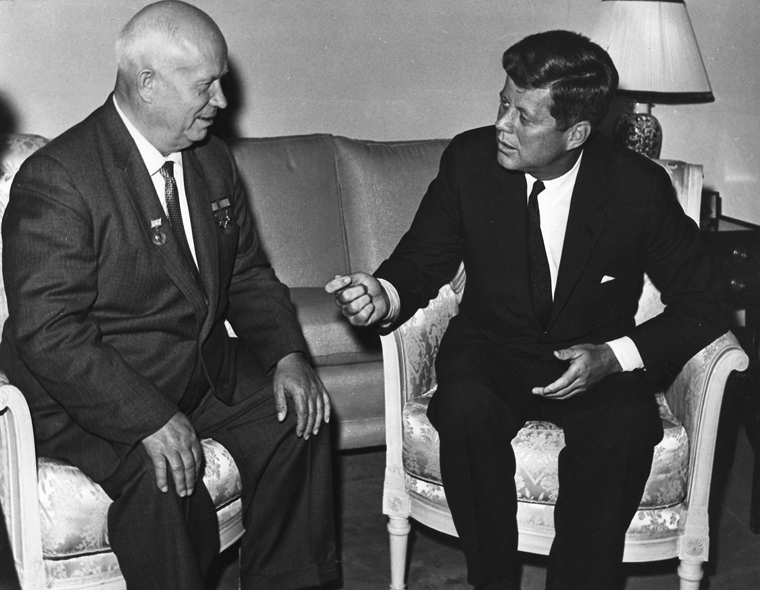 President Kennedy meets with Chairman Khrushchev at the U. S. Embassy residence, Vienna. June 1961.
President Kennedy meets with Chairman Khrushchev at the U. S. Embassy residence, Vienna. June 1961.June 3, 1961
- President Kennedy and Premier Khrushchev met in Vienna. They had agreed to discuss the peace settlement in Laos, nuclear disarmament and the situation in West Berlin. However, Khrushchev was only interested in Berlin. His objective was to force the US out of West Berlin and he used the meeting to bully Kennedy. Kennedy felt defeated in the encounter.
- Khrushchev threatened to sign a peace treaty with East Germany that would effectively cut off US rights of access to West Berlin. The problem Khrushchev wanted to solve for East Germany and the Soviet Union was the allure of the Western presence. East Germans, attracted by higher living standards in the West, were using the divided city of West Berlin to escape from the communist government. 130,000 citizens had crossed from East Berlin into West Berlin in the first seven months of 1961.
June 15, 1961
- Khrushchev publicly criticized Kennedy and the “capitalists” for the lack of progress on Berlin negotiations, and suggesting that a Cold War was a period of preparing for war.
First half of 1961
- The US began installation of nuclear-equipped Jupiter medium-range ballistic missiles in Turkey that were capable of reaching Moscow. They would be operational by March 1962.
August 13, 1961
- The East German leader, Walter Ulbricht, shut off travel between East and West Berlin, halting the exodus of East Germans by surrounding West Berlin with a wall, and re-routing rail traffic around West Berlin. The Americans agreed to end civilian travel across the sectoral lines.
As Seen by the USSR
September 4, 1961
- In a letter, Castro requested the USSR provide 388 SAMs and other military assistance. Castro also wanted the USSR to buy its sugar and to supply the country with oil. Initially, Khrushchev delayed action on the request for military assistance as he had not wanted to antagonize the US over Cuba.
October 30, 1961
- The Soviets exploded the 50-megaton Tsar Bomba (3,333 times the force of the bomb used on Hiroshima) at 13,000 feet above Severny Island in the Artic Ocean. 9
February 1962
- Khrushchev learned the US was about to deploy the Minuteman missile.10
- Castro forced Khrushchev’s hand by suggesting Cuba might align with the Chinese Communists rather than the Soviets.
For an entire year after Castro declared himself a communist, Khrushchev wouldn’t call him “comrade.”
Castro had to up the ante by turning against the old communists in Cuba. He removed them from leading positions, sending the message to Khrushchev that he could join Mao’s China instead. Khrushchev got the message, calling Castro “comrade” in April of 1962.
One month later, he decided to move missiles to Cuba, in part to keep the newly communist Castro in his communist camp.11
April 12, 1962
- The Presidium agreed to send Cuba 180 anti-aircraft surface to air missiles and Sopka cruise missiles that could be used against ships. The Soviets also sent equipment that had not been requested: 10 bombers, 4 cruise missile launchers and 650 men to operate and teach the Cubans how to operate the equipment. The purpose was to repel an invasion by the US.
- Four days later, the Presidium authorized the development of new ballistic missiles, ICBMs, that would be capable of delivering nuclear warheads to the US.
April 25, 1962
- The US resumed atmospheric nuclear testing, exploding a bomb at Christmas Island.
Mid-May 1962
- Khrushchev devised a plan to both keep the Cubans in his Soviet camp, and achieve a nuclear deterrent to the US. Castro would gain the Soviet military support he wanted with the installation of Soviet short- and medium-range ballistic missiles in Cuba and the Soviets would have weapons that could reach Washington, D.C. (The Soviet’s eastern European based weapons were not capable of reaching the US)
May 21-23, 1962
- Khrushchev asked his Defense Council to place medium and intermediate-range missiles in Cuba. The stated purpose was to defend Cuba, not to achieve parity with the US.
- Their plan was to send 44,000 officers and soldiers plus 1,300 civilians to Cuba. It was estimated that 70-80 ships would be needed for transport. In total, 40 medium and intermediate missile launchers would be installed for 60 missiles and 60 warheads. Missiles were to be transported in two shipments beginning in early July, with men arriving by September. The medium range missiles would be ready to launch within 10 days of arrival, while the intermediate range missiles would take 4 months.
May 28, 1962
- Soviets arrived in Cuba and asked for Castro’s agreement to place missiles there. Castro continued to request an agreement, like the Warsaw pact, that the USSR would protect Cuba if the US invaded. On May 30, the Cuban Communist Party agreed to accept the Soviet missiles.
May 31, 1962
- The commander of the Soviet Strategic Missile Forces, Marshal Biriuzev, and Raul Castro surveyed the island for missile sites and realized they couldn’t be hidden, but when Biriuzev returned to Moscow on June 10, he gave the message that Khrushchev wanted to hear – missiles could be hidden and Cuba would accept them.
July 5, 1962
- Khrushchev demanded that the Western allies withdraw from Berlin, on “threat of peace” if they did not. Unbeknownst to the United States, Khrushchev was toying with Kennedy to keep him focused on Berlin. Khrushchev knew Kennedy feared the political consequences of a deterioration in the West’s position vis-à-vis the Soviet-controlled East Berlin.
As Seen by the US
In JFK’s reply to the July 5th demand, he cautioned that despite the wishes of leadership, a failure of communications, misunderstandings and mutual irritation could lead to nuclear war.
As Seen by the USSR
July 10, 1962
- Soviet generals departed for Cuba. Missiles slated for Cuba would be removed from three regiments located in northeastern Ukraine on the border with Russia and two in Northern Ukraine and Lithuania. These were the least useful Soviet placements as they could not reach many strategic European targets.
In perhaps an early blunder, Khrushchev selected Colonel General Issa Pliev as commander of the “Group of Soviet Troops in Cuba.” Pliev was a 60 year-old trusted cavalry veteran who had successfully commanded different branches of the armed forces and who had successfully suppressed a revolt over food shortages. His cavalry background was not impressive to the younger officers. These officers understood how to handle the missiles and the new concepts of warfare; Pliev didn’t.
The problems encountered were legion and many could have been reduced with proper advanced planning. Not only was there inadequate vegetation to hide the missiles, but the heat and humidity overwhelmed the troops and the missiles. For example, roads and bridges were inadequate for transporting the missiles from the ships to the launch pads and had to be reconstructed. Cuban electricity had a frequency of 60 Hertz whereas Soviet equipment was designed for 50 Hertz.
Despite these problems, the Soviets found ways to get the job done. Most importantly, realizing their nuclear missiles couldn’t be hidden adequately from observation by U-2 planes, they changed plans and sent anti-aircraft missiles to Cuba ahead of the nuclear weapons. This would enable them to shoot down the U-2’s before they could send pictures of the nuclear emplacements to the CIA.
Berlin had been the primary focus of US foreign policy, and Cuba had been seen through that lens. That would no longer suffice – the threat posed by Soviet activities in Cuba took center stage.
As Seen by the US
July 25, 1962
- Khrushchev told US Ambassador Llewellyn Thompson that he wanted to help Kennedy. He conveyed a question: ‘would Kennedy prefer to settle the Berlin question before or after the mid-term election?’ When the same message was conveyed separately to Robert Kennedy, a request was added: ‘stop overflights of ships traveling to Cuba.’
July 30
- JFK met with a Soviet representative, expressing his interest in a deal on Berlin.
August 1, 1962
- The CIA’s assessment: the Soviet’s provision of arms and equipment to Cuba was for defensive purposes.
August 7, 1962
- A Miami-based Cuban radio station reported that 4,000 Soviet soldiers had arrived in July.
August 10, 1962
- Among the intelligence reports John McCone, head of the CIA, received was the following:
A refugee arriving in Miami reported driving by a long truck convoy in the early morning hours of August 5: ‘After about every third truck there was a long flatbed pulled by a tractor-like vehicle. On each vehicle there was a round object as tall as a palm tree and covered by a tarpaulin.’12
August 21, 1962
- John McCone reported to Robert Kennedy and his group monitoring Cuban activities that 21 Soviet ships had arrived in Cuba in July and 17 more had arrived in August or were still on their way. He said 4,000 to 6,000 troops had also arrived in July. Although he didn’t know the contents of the cargo, the crates “suggested airplane parts and missiles.” There was also radar equipment. Further, the CIA thought that surface-to-air missiles were being brought to Cuba. Robert Kennedy’s group immediately began considering a response.
- The US saw the Cuba problem through the lens of Berlin. They worried what the USSR would do in Berlin if the US addressed the military threat discovered in Cuba. Up to this point, the role of the group (code named Operation Mongoose), had been sabotage and psychological warfare against Castro. Now, its mission was to determine how to respond to the increased presence of the USSR in Cuba.
- The President was completely surprised when McCone reported the news on August 22. Just before meeting with McCone, JFK had told a press conference that no Soviet soldiers were in Cuba, only technicians.
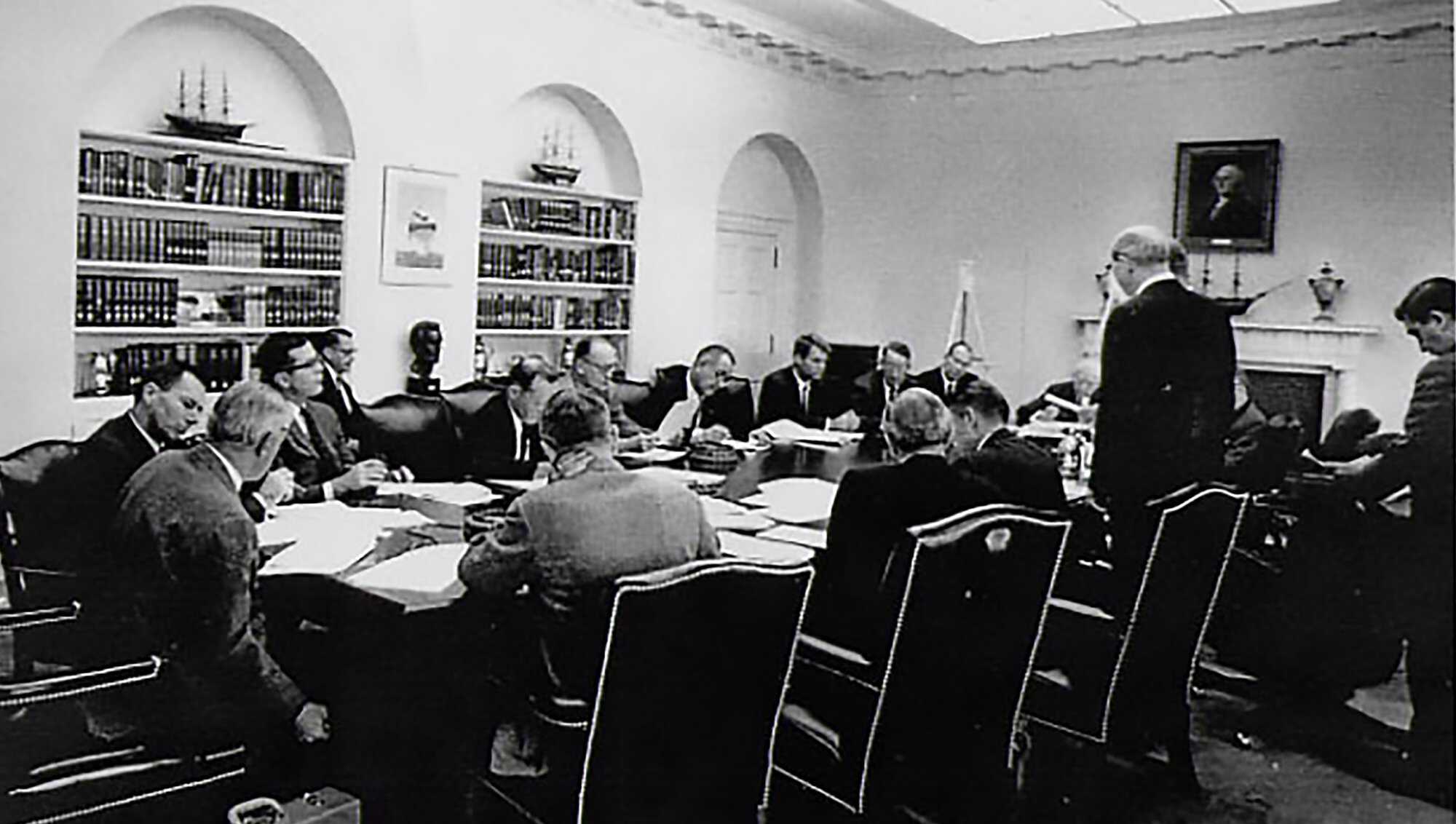 Meeting of Operation Mongoose
Meeting of Operation MongooseThe Special Group Augmented (SGA) was charged with overthrowing Castro’s government. The SGA, chaired by Robert F. Kennedy (Attorney General), included John McCone (CIA Director), McGeorge Bundy (National Security Adviser), Alexis Johnson (State Department), Roswell Gilpatric (Defence Department), General Lyman Lemnitzer (Joint Chiefs of Staff) and General Maxwell Taylor. Although not officially members, Dean Rusk (Secretary of State) and Robert S. McNamara (Secretary of Defense) also attended meetings.
This covert action program for sabotage and subversion against Cuba was called Operation Mongoose. Robert Kennedy also decided that General Edward Lansdale (Staff Member of the President’s Committee on Military Assistance) should be placed in charge of the operation. 13
As Seen by the USSR
August 1 – mid-August 1962
- Construction began on the SAM sites during the first week of August and ended mid-August.
August 19, 1962
- Despite what he said in his July 25th meeting with Ambassador Thompson, Khrushchev was not anxious to change the status of East Berlin. East Germany’s Ulbricht had successfully walled off West Berlin to stem the flow of migrants to the West, so his Berlin problem was solved. However, Khrushchev kept the game going to distract Kennedy.
August 19, 1962
- MRBMs arrived in Cuba, but couldn’t dock until September 9 because the dock could handle only one ship at a time and there was nowhere to store the missiles and equipment. They were expected to be combat-ready by 11/1/62. IRBMs were to be combat-ready between 11/1/62 – 1/1/63.
August 22, 1962
- The Soviets abolished their commandant in Berlin, forcing the commandants of the Western sectors to deal directly with East Germany, thereby giving the state some legitimacy.
As Seen by the US
August 23, 1962
- JFK met with his advisors to consider a response to the Soviet’s abolition of their Berlin commandant. Kennedy feared the issue would come to a head before the end of the year.
August 27, 1962
- President Kennedy and British Prime Minister Harold MacMillan proposed to enter into an agreement with the Soviet Union to ban nuclear tests in the atmosphere, under water and in outer space.
- In a National Security Action memo, Kennedy asked what action could be taken to get the US’s Jupiter missiles out of Turkey. 14
August 29, 1962
- Despite knowing otherwise, Kennedy again denied there were Soviet troops in Cuba and also denied that the US planned to invade the island. He believed that the worst thing that could happen would be for his actions in Cuba to provoke a crisis in West Berlin leading to a blockade of the city, military engagement with the USSR and eventually, nuclear war.
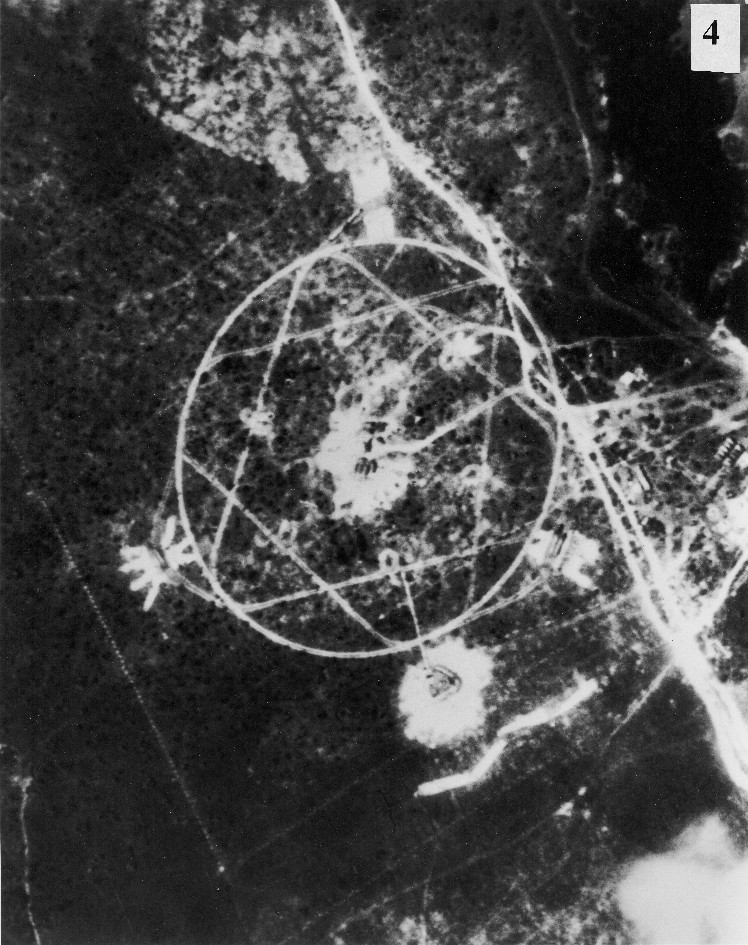 Surface-to-air missile site under construction at La Coloma. August 29, 1962.
Surface-to-air missile site under construction at La Coloma. August 29, 1962.August 30, 1962
- A US U-2 strayed over the USSR near Sakhalin Island in the Far East. The US apologized.
- The US knew the Soviets had delivered anti-aircraft missile to Cuba but assumed the Soviet military buildup was only a defensive measure. The first shipment, that of communications equipment, arrived on August 30, 1962, and ballistic missiles began arriving on September 9. The number of US overflights of Soviet ships increased (and Khrushchev complained to Kennedy about the harassment.)
- Media reported increased Soviet sea traffic to Cuba, and a large number of Soviet troops on the island. The crisis arose when on August 29, a U-2 flight over Cuba discovered surface-to-air missiles, SAMs, of the same type that had shot down a U-2 over the USSR in May 1960.
August 31, 1962 Friday before Labor Day
- General Marshall Carter, Acting CIA Director, informed President Kennedy of the discovery of SAMs. The pictures revealed eight sites in Cuba, each hosting six launchpads with a central command cabin and radar.
As September 1962 began
- With this information, President Kennedy knew he had both a political and a military problem as the mid-term elections were approaching. New York’s Republican senator, Kenneth Keating, had been raising an alarm about Soviet presence in Cuba, and now it was clear that he was right. Though there had been no evidence, he had learned that the commander of the US Naval Base at Guantanamo, Admiral O’Donnell, believed missile sites were being constructed in Cuba. Causing further concern were the reports by Cuban refugees of the presence of Soviet troops. The Admiral believed there were 3,000 to 5,000 Soviet technicians on the island and that more than twenty cargo ships had arrived.
- Dealing first with the political problem, Kennedy asked Carter to keep silent about the discovery until he determined how to handle it. To address the military problem, he planned a meeting with his top advisors for the day after Labor Day.
- In that September 4, 1962 meeting, Dean Rusk proposed a statement for the President. In it he wrote that a deployment of offensive weapons for use by Cubans would be met with immediate and appropriate action. The question was, what did appropriate action mean and what defined offensive weapons. What should provoke a US invasion? What steps should the US take to avoid escalation?
- Rusk and McNamara wanted to blockade the island, but the President wanted to save that option as leverage against a potential Soviet blockade of West Berlin. A fallback action was quickly agreed to: a mobilization of US troop reserves. Mobilization would be necessary with either a blockade or an invasion, and it would be welcomed by a Congress anxious to repel the Soviets.
- McCone believed the SAMs were put in Cuba to protect the delivery of nuclear weapons, but the President did not learn of his views as McCone was honeymooning in the French Riviera during the first week of September. He had cabled this perspective to his deputy General Marshall Carter, but Carter did not share the cables with the President at the September 4th meeting, nor did he convince members of the administration of the danger presented and the need for constant monitoring overflights.
Continue
to Cuban Missile Crisis September 1962
Notes
Pages on this site describing events of the Cuban Missile Crises are based primarily on: Serhii Plokhii, Nuclear Folly: A History of the Cuban Missile Crisis, W. W. Norton & Company, New York. 2021.
1 https://www.nytimes.com/2003/09/14/weekinreview/word-for-word-khrushchev-unplugged-middle-east-cuba-fine-art-political-bluster.html
2 en.wikipedia.org/wiki/PGM-19_Jupiter
3 https//www.JFKLibrary.org/earn/about-jfk/jfk-in-history/the-bay-of-pigs
4 https//www.JFKLibrary.org/earn/about-jfk/jfk-in-history/the-bay-of-pigs
5 Ibid.
6 A solid fuel rocket has its fuel and oxidant mixed together as fine powders and then pressed in to a solid ‘cake’. Once it has been lit it will carry on burning until it is used up. Source:the European Space Agency; https://www.esa.int/Education/Solid_and_liquid_fuel_rockets
7 history.com/this-day-inhistory/first-man-in-space
8 https//www.jfklibrary.org/team/about-jfk/jfk-in-history/the-bay-of-pigs
9 https://www.nationalww2museum.org/war/articles/tsar-bomba-largest-atomic-test-world-history
10 The first minuteman was actually installed in Montana on October 26, 1962. See https://www.nps.gov/articles/minuteman-icbm.htm
11 Serhii Plokhii huri.harvard,edu/news/nuclear-folly-serhii-plokhiis-latest-book-examines-cuban-misile-crisis.
12 Richard Reeves, President Kennedy, Simon & Schuster, New York. 1993. p. 339
13 Reeves, p. 342
14 Reeves, p. 702
Photos
U.S. Jupiter Missile. Source: U.S. Army Missile Command. Public Domain via Wikimedia Commons.
Celebrating Cuban Revolution. Photograph Source: Museo Che Guevara – Public Domain.
President Kennedy meets with Chairman Khrushchev. Source: U.S. Department of State in the John F. Kennedy Library and Museum, Boston. Public Domain.
Meeting of Operation Mongoose. Courtesy: Cecil Stroughton. John F. Kennedy Library and Museum, Boston. Public Domain.
Surface-to-Air missile site under construction. Source: National Security Archive. https://nsarchive2.gwu.edu/nsa/cuba_mis_cri/4.jpg